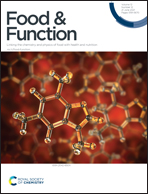Carboxymethyl konjac glucomannan coating on multilayered emulsions for improved bioavailability and targeted delivery of curcumin
Abstract
Curcumin was entrapped in multilayered emulsions to increase its stability and bioavailability. Curcumin emulsion stabilized by whey protein isolate (WPI) was coated with chitosan (CHI) or carboxymethyl konjac glucomannan (CMKGM) alone to form secondary emulsions and their combination in sequence to form the tertiary emulsion, in which, the polyelectrolyte concentrations were 1.0% WPI for the primary emulsion, 0.4% CMKGM for the secondary emulsion –CMKGM, 0.2% CHI for the secondary emulsion –CHI, and 0.1% CMKGM for the tertiary emulsion. The characteristics of the emulsions, including their particle size, ζ potential, microstructure, creaming stability, and biopolymer distribution, were investigated and their colon-targeted delivery potential was evaluated through both in vitro and in vivo studies as well. The curcumin-loaded secondary and tertiary emulsions were stable with a narrow size distribution and were generated by layer-by-layer assembly according to confocal laser scanning microscope observation. When CMKGM was located at the outermost layer, the corresponding secondary and tertiary emulsions showed a greatly reduced release of curcumin in the simulated gastric fluid, but exhibited increased release in the β-mannanase-containing simulated colonic fluid. In vivo evaluation in mice demonstrated that the bioavailability of curcumin in the CMKGM-coated secondary and tertiary emulsions was increased by about 4 folds compared with that of free curcumin and curcumin could be released in a sustainable manner. These results demonstrated that multilayered emulsions coated with CMKGM could promote curcumin absorption in the gastrointestinal tract and hence is a promising colon-targeted delivery system for curcumin.



 Please wait while we load your content...
Please wait while we load your content...